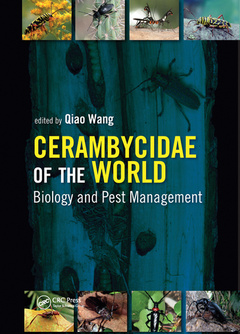Description
Cerambycidae of the World
Biology and Pest Management
Contemporary Topics in Entomology Series
Coordinator: Wang Qiao
Language: English
Subjects for Cerambycidae of the World:
Keywords
Cerambycid Species; Anoplophora Glabripennis; species; Larval Host; phoracantha; Infested Trees; semipunctata; Pine Wilt Disease; anoplophora; Anoplophora Chinensis; glabripennis; Phoracantha Semipunctata; larval; Host Tree; host; Cambial Region; pine; Longhorned Beetle; wilt; Host Plant Volatiles; disease; Aggregation Pheromones; Adults Emerge; Larvae Tunnel; Sex Pheromones; Neonate Larvae; Pupal Cells; Infestation Rate; Entomopathogenic Nematodes; Larval Mortality; General Biology; Wood Packaging Materials; Bark Beetle; Plant Volatiles; Natural Enemy Communities
Publication date: 06-2020
· 17.8x25.4 cm · Paperback
Publication date: 01-2017
· 17.8x25.4 cm · Hardback
Description
/li>Contents
/li>Readership
/li>Biography
/li>
Wang has gathered contributions from an impressive cohort of the world?s most respected experts on longhorned beetles. Chapters review both basics of cerambycid taxonomy, mor- phology, and behavior (feeding, reproduction, and chemical ecology), as well as more applied concerns, such as laboratory rearing, pest control, and bio- security. Overall, this volume is a valuable contribution to the literature as a "one-stop shop" for readers seeking a comprehensive overview of longhorned beetles... It represents a tremendous effort on the part of Wang and the authors, and has resulted in a much-needed update to the literature. This volume is the only work of its kind available at this time, and is a valuable addition to the library of any scientist studying wood-boring beetles.
- Ann M. Ray, Biology, Xavier University, Cincinnati, Ohioin The Quarterly Review of Biology, Volume 94, 2019
There are more than 36,000 described species in the family Cerambycidae in the world. With the significant increase of international trade in the recent decades, many cerambycid species have become major plant pests outside their natural distribution range, causing serious environmental problems at great cost.Cerambycid pests of field, vine, and tree crops and of forest and urban trees cost billions of dollars in production losses, damage to landscapes, and management expenditures worldwide.
Cerambycidae of the World: Biology and Pest Management is the first comprehensive text dealing with all aspects of cerambycid beetles in a global context. It presents our current knowledge on the biology, classification, ecology, plant disease transmission, and biological, cultural, and chemical control tactics including biosecurity measures from across the world.
Written by a team of global experts, this book provides an entrance to the scientific literature on Cerambycidae for scientists in research institutions, primary industries, and universities, and will serve as an essential reference for agricultural and quarantine professionals in governmental departments throughout the world.
Preface
Editor
Contributors
1. General Morphology, Classification, and Biology of Cerambycidae
Marcela L. Monné, Miguel A. Monné, and Qiao Wang
2. Life History and Population Dynamics of Cerambycids
Robert A. Haack, Melody A. Keena, and Dominic Eyre
3. Feeding Biology of Cerambycids
Robert A. Haack
4. Reproductive Biology of Cerambycids
Lawrence M. Hanks and Qiao Wang
5. Chemical Ecology of Cerambycids
Jocelyn G. Millar and Lawrence M. Hanks
6. Cerambycids as Plant Disease Vectors with Special Reference to Pine Wilt
Süleyman Akbulut, Katsumi Togashi, and Marc J. Linit
7. Laboratory Rearing and Handling of Cerambycids
Melody A. Keena
8. Natural Enemies and Biological Control of Cerambycid Pests
Timothy D. Paine
9. Cultural Control of Cerambycid Pests
Qiao Wang
10. Chemical Control of Cerambycid Pests
Qiao Wang
11. Cerambycid Pests in Forests and Urban Trees
Robert A. Haack
12. Cerambycid Pests in Agricultural and Horticultural Crops
Qiao Wang
13. Invasive Cerambycid Pests and Biosecurity Measures
Dominic Eyre and Robert A. Haack
Index
Qiao Wang, PhD, is a professor of entomology at the Institute of Agriculture and Environment, Massey University, Palmerston North, New Zealand. He earned his MSc under Professor Shu-nan Chiang from Southwest Agricultural University, Chongqing, China, PhD under Professors Ian W.B. Thornton and Tim R. New from La Trobe University, Melbourne, Australia, and postdoctoral experience under Professor Jocelyn G. Millar from the University of California, Riverside, before joining Massey University. He has studied cerambycid beetles since 1982. His research team currently focuses on plant protection, insect behavior, biological control, and evolutionary biology. Dr. Wang’s experience in Australia, China, New Zealand, and the United States is reflected in his more than 300 publications; work with more than 70 postgraduate, postdoctoral, and visiting scientists from around the world; service on editorial boards of a number of international journals and international expert panels; and chairmanship of international conference sessions. Dr. Wang was awarded the 2012 Distinguished Scientist Award by the Entomological Society of America for his outstanding contributions to entomological science during his career.
These books may interest you

The Grape Entomology 158.24 €



